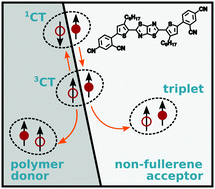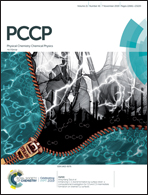Impact of the donor polymer on recombination via triplet excitons in a fullerene-free organic solar cell†
Abstract
The greater chemical tunability of non-fullerene acceptors enables fine-tuning of the donor–acceptor energy level offsets, a promising strategy towards increasing the open-circuit voltage in organic solar cells. Unfortunately, this approach could open an additional recombination channel for the charge-transfer (CT) state via a lower-lying donor or acceptor triplet level. In this work we investigate such electron and hole back-transfer mechanisms in fullerene-free solar cells incorporating the novel molecular acceptor 2,4-diCN-Ph-DTTzTz. The transition to the low-driving force regime is studied by comparing blends with well-established donor polymers P3HT and MDMO-PPV, which allows for variation of the energetic offsets at the donor–acceptor interface. Combining various optical spectroscopic techniques, the CT process and subsequent triplet formation are systematically investigated. Although both back-transfer mechanisms are found to be energetically feasible in both blends, markedly different triplet-mediated recombination processes are observed for the two systems. The kinetic suppression of electron back-transfer in the blend with P3HT suggests that energy losses due to triplet formation on the polymer can be avoided, regardless of favorable energetic alignment.



 Please wait while we load your content...
Please wait while we load your content...